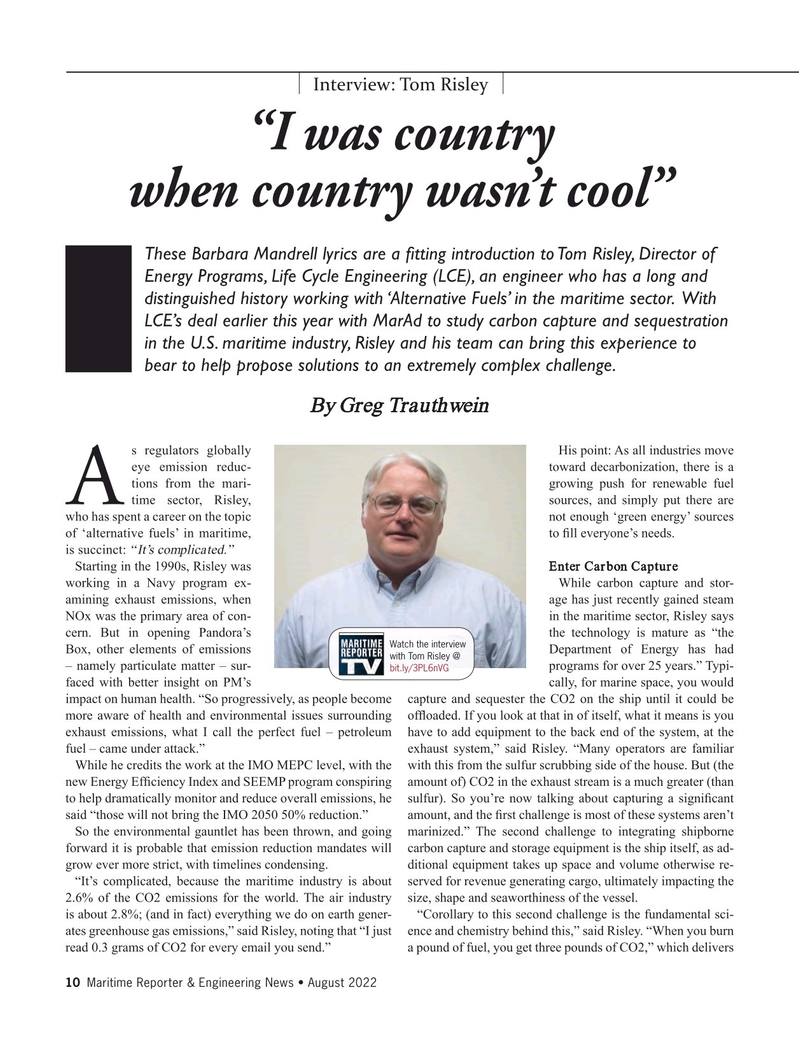
Page 10: of Maritime Reporter Magazine (August 2022)
The Shipyard Annual
Read this page in Pdf, Flash or Html5 edition of August 2022 Maritime Reporter Magazine
Interview: Tom Risley “I was country when country wasn’t cool”
These Barbara Mandrell lyrics are a ftting introduction to Tom Risley, Director of
Energy Programs, Life Cycle Engineering (LCE), an engineer who has a long and distinguished history working with ‘Alternative Fuels’ in the maritime sector. With
LCE’s deal earlier this year with MarAd to study carbon capture and sequestration in the U.S. maritime industry, Risley and his team can bring this experience to bear to help propose solutions to an extremely complex challenge.
By Greg Trauthwein s regulators globally His point: As all industries move eye emission reduc- toward decarbonization, there is a tions from the mari- growing push for renewable fuel
A time sector, Risley, sources, and simply put there are who has spent a career on the topic not enough ‘green energy’ sources of ‘alternative fuels’ in maritime, to fll everyone’s needs.
is succinct: “It’s complicated.”
Starting in the 1990s, Risley was Enter Carbon Capture working in a Navy program ex- While carbon capture and stor- amining exhaust emissions, when age has just recently gained steam
NOx was the primary area of con- in the maritime sector, Risley says cern. But in opening Pandora’s the technology is mature as “the
Watch the interview
Box, other elements of emissions Department of Energy has had with Tom Risley @ – namely particulate matter – sur- programs for over 25 years.” Typi- bit.ly/3PL6nVG faced with better insight on PM’s cally, for marine space, you would impact on human health. “So progressively, as people become capture and sequester the CO2 on the ship until it could be more aware of health and environmental issues surrounding offoaded. If you look at that in of itself, what it means is you exhaust emissions, what I call the perfect fuel – petroleum have to add equipment to the back end of the system, at the fuel – came under attack.” exhaust system,” said Risley. “Many operators are familiar
While he credits the work at the IMO MEPC level, with the with this from the sulfur scrubbing side of the house. But (the new Energy Effciency Index and SEEMP program conspiring amount of) CO2 in the exhaust stream is a much greater (than to help dramatically monitor and reduce overall emissions, he sulfur). So you’re now talking about capturing a signifcant said “those will not bring the IMO 2050 50% reduction.” amount, and the frst challenge is most of these systems aren’t
So the environmental gauntlet has been thrown, and going marinized.” The second challenge to integrating shipborne forward it is probable that emission reduction mandates will carbon capture and storage equipment is the ship itself, as ad- grow ever more strict, with timelines condensing. ditional equipment takes up space and volume otherwise re- “It’s complicated, because the maritime industry is about served for revenue generating cargo, ultimately impacting the 2.6% of the CO2 emissions for the world. The air industry size, shape and seaworthiness of the vessel.
is about 2.8%; (and in fact) everything we do on earth gener- “Corollary to this second challenge is the fundamental sci- ates greenhouse gas emissions,” said Risley, noting that “I just ence and chemistry behind this,” said Risley. “When you burn read 0.3 grams of CO2 for every email you send.” a pound of fuel, you get three pounds of CO2,” which delivers 10 Maritime Reporter & Engineering News • August 2022

 9
9

 11
11
